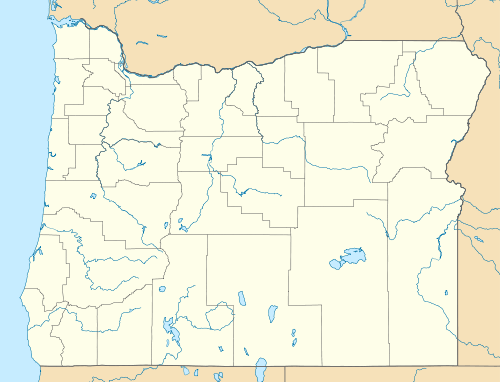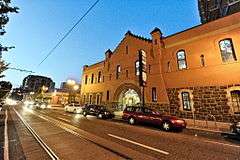First Regiment Armory Annex
|
First Regiment Armory Annex | |
|
Portland Armory at dusk | |
  | |
| Location |
128 NW 11th Avenue Portland, Oregon |
|---|---|
| Coordinates | 45°31′27″N 122°40′54″W / 45.524166°N 122.681639°WCoordinates: 45°31′27″N 122°40′54″W / 45.524166°N 122.681639°W |
| Area | less than one acre |
| Built | 1891 |
| Architect | McCaw and Martin |
| Architectural style | Romanesque Revival |
| NRHP Reference # | 00001017[1] |
| Added to NRHP | August 31, 2000 |
The First Regiment Armory Annex, commonly known as the Portland Armory, is a historic building in Portland, Oregon, United States. It was built in 1891 by Multnomah County to house the Oregon National Guard. In 2000, it was added to the National Register of Historic Places. Following a renovation project that lasted from 2002 to 2006, the building now houses Gerding Theater, used primarily by the theatre group Portland Center Stage.
Construction
In the late 19th century, anti-Chinese sentiment, particularly along the West Coast of the United States, had led to anti-Chinese violence in Oregon and Washington. After violence turned to riot in some cases (such as in Seattle), the State of Oregon authorized construction of armories so that National Guard troops could drill, in an effort to prevent or control potential riots.[2][3]
The First Regiment Armory in Portland was completed in 1888, but was immediately deemed too small, and so an Annex was commissioned to give troops stationed there more space for maneuvers. Amenities included an underground firing range.[2][3] Constructed in 1891, the annex was built in the Romanesque Revival style that was popular from 1880–1890 and is identified by massive stone cladding and semi-circular arcades. McCaw and Martin featured many Northwest quarry materials in the design.[4] The annex is also an example of Castellated architecture. The fortress-like structure has a recessed arched entrance flanked by turrets above. The turrets have crenelated parapets and loophole vertical gun slots.[5]
Uses

Constructed with a truss system with no supporting pillars to block views or impede movement, the building was one of the few Portland buildings in the early 20th century that could handle large crowds.[2] As a result, the building hosted exhibitions of early motion picture machines, conventions, reunions, recitals, concerts, and speeches by presidents Theodore Roosevelt, William Howard Taft, and Woodrow Wilson.[3] In 1918, the new Municipal Auditorium (now called Keller Auditorium), designed with superior acoustics and comfortable seating, supplanted the Armory for concerts and speeches, though amateur boxing events were still held at the Armory.[2]
In 1928, the Portland fire marshal declared the building to be a fire hazard; nonetheless, the building continued to be used. From 1946 to 1948, the Armory was home to the Portland Indians of the Pacific Coast Professional Basketball League.[3][6] In 1948, the building was used to take in refugees of the Vanport Flood which destroyed the town of Vanport in 1948.[3]
In 1968, the Blitz-Weinhard Brewing Company purchased the entire complex, demolishing the original Armory for a parking lot and using the Annex as a warehouse.[3]
Present use

The Armory Annex, now known as the Portland Armory, was the last piece of property in Portland's Pearl District Brewery Blocks to be redeveloped. The Portland development firm Gerding Edlen had redeveloped surrounding properties utilizing sustainable building practices and, when they bought the Armory complex in 2000, they pledged to maintain the historical character of the building while redeveloping the property.[4]
The Portland Armory now contains the 600-seat Gerding Theater. The reinvention of the building as an arts center was contemplated as early as 2003.[7] The renovation cost $36.1 million.[8]
The Armory has become a significant case study for historic preservation and sustainable design. It received a Platinum Leadership in Energy and Environmental Design (LEED) Certification,[9] becoming the first building on the National Register and the first in Portland to achieve Platinum certification.[10] As of 2007, it was one of only two Portland buildings to attain that status.[11] Some of the green features include a catch system for rainwater, displacement ventilation systems, skylights for additional natural lighting and bicycle parking spaces.
See also
References
- ↑ National Park Service (2010-07-09). "National Register Information System". National Register of Historic Places. National Park Service.
- 1 2 3 4 "History". Portland Center Stage. Archived from the original on September 7, 2008. Retrieved 2008-05-29.
- 1 2 3 4 5 6 "History". Voices of the Armory. Archived from the original on 2007-05-29. Retrieved 2008-05-28.
- 1 2 breweryblocks.com Portland Armory
- ↑ John M. Tess (November 24, 1999). "National Register of Historic Places Registration Form: First Regiment Armory Annex" (PDF). National Park Service. Retrieved January 24, 2016. Accompanying nine photos from 1999, and one earlier, undated, photo.
- ↑ Kenyon, J. Michael. "Pacific Coast Professional Basketball League 1946–47 to 1947–48". Association for Professional Basketball Research. Retrieved 2008-05-28.
- ↑ Senior, Jeanie (July 15, 2003). "Armory may get an arts overhaul". Portland Tribune. Retrieved 2008-05-27.
- ↑ Oppegaard, Brett (September 29, 2006). "Portland Center Stage - Dramatic space.". The Columbian. Retrieved 2008-05-27.
- ↑ "The Building". Portland Center Stage. Archived from the original on 2008-04-28. Retrieved 2008-05-29.
- ↑ "Portland Armory Earns LEED Platinum Award" (PDF) (Press release). Green Building Services. 2006-10-01. Archived from the original (PDF) on 2012-02-13. Retrieved 2008-05-29.
- ↑ Weinberger, Dawn (April 17, 2007). "Patients get platinum". Retrieved 2008-05-28.
| Wikimedia Commons has media related to First Regiment Armory Annex. |
